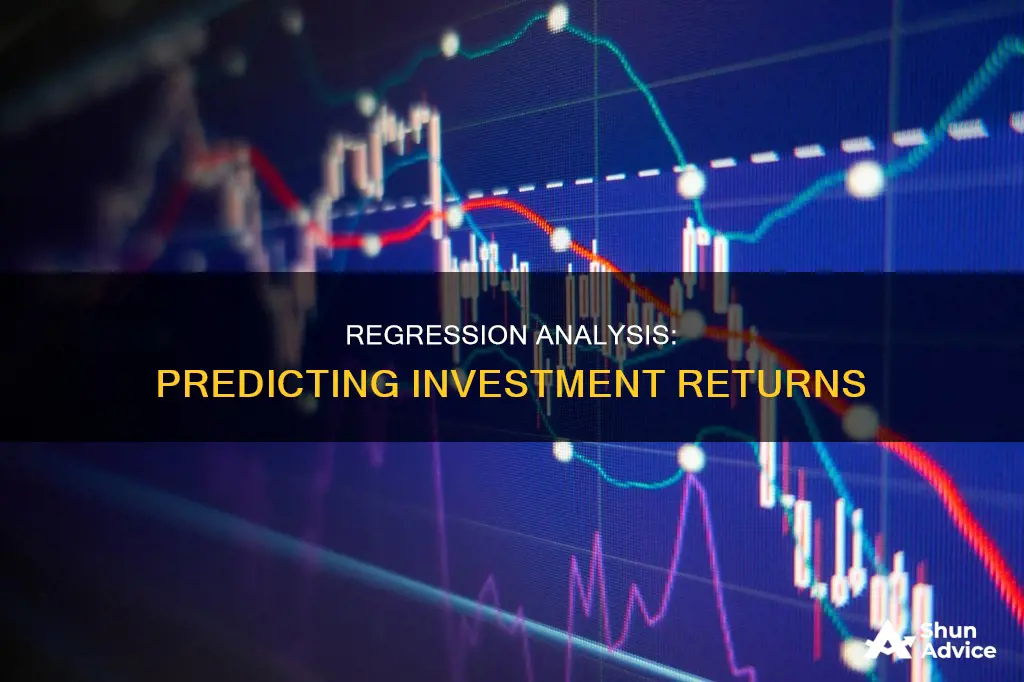
Regression analysis is a statistical method used in finance and investing to determine the strength of the relationship between a dependent variable and one or more independent variables. It is a powerful tool for making data-driven decisions and improving products and services. In finance, regression analysis is used to calculate the Beta (volatility of returns relative to the overall market) for a stock and to forecast revenues and expenses. It can also be used to assess the relationship between factors such as commodity prices and the stocks of businesses dealing in those commodities.
| Characteristics | Values |
|---|---|
| Use | To determine the strength and character of the relationship between a dependent variable and one or more independent variables |
| Type | Statistical method |
| Data | Two or more pieces of data |
| Application | Can be applied to various disciplines, including finance |
| Advantages | Provides detailed insight that can be applied to further improve products and services |
| Can be used to make more informed business decisions, allocate resources more efficiently, and ultimately boost the bottom line | |
| Disadvantages | Cannot easily indicate causation |
What You'll Learn
- Regression analysis can be used to calculate the Beta (volatility of returns relative to the overall market) for a stock
- It can be used to forecast revenues and expenses
- It can be used to determine the strength of the relationship between variables
- It can be used to predict sales
- It can be used to value assets

Regression analysis can be used to calculate the Beta (volatility of returns relative to the overall market) for a stock
Regression analysis is a useful tool for investors to calculate the Beta (β) of a stock, which is a measure of the volatility or systematic risk of a security or portfolio compared to the market as a whole. Beta is calculated by finding the slope of the regression line, which represents the rate of change between the "general-market" and "stock-specific" returns.
Beta is derived by comparing the returns of an individual security or portfolio to the returns of the overall market, typically using the S&P 500 as the benchmark. By doing so, investors can identify the proportion of risk that can be attributed to the market and determine how sensitive a stock's price is to market movements.
The Beta coefficient is calculated by dividing the covariance of the excess asset returns and excess market returns by the variance of the excess market returns over the risk-free rate of return. This calculation can be performed in Microsoft Excel using the historical series of share prices for the company being analysed.
The Beta value of a stock provides valuable insights for investors. A Beta greater than 1 indicates that the stock is more volatile than the market, while a Beta less than 1 suggests that the stock is less volatile. A Beta of 1 means that the stock's price activity is strongly correlated with the market, and adding it to a portfolio does not increase the risk.
When calculating Beta, investors should consider factors such as the estimation period, return interval, choice of market index, and smoothing techniques. Additionally, it is important to ensure that the market used as a benchmark is relevant to the stock being analysed.
What Investment Bankers Actually Do
You may want to see also

It can be used to forecast revenues and expenses
Regression analysis is a powerful tool for forecasting revenues and expenses. It can be used to predict sales and revenue based on various factors, such as the number of salespeople, advertising spend, weather conditions, previous sales, gross domestic product (GDP) growth, or other economic indicators.
For example, a company can use regression analysis to understand the relationship between the number of salespeople and the revenue generated. By analysing historical data, they can determine if there is a positive correlation between the number of salespeople and sales, and use that relationship to forecast future revenue. This can help them make informed decisions about hiring more salespeople or expanding their business.
Regression analysis can also be applied to understand the impact of advertising spend on sales. By examining past data, companies can determine if there is a significant relationship between advertising expenditure and sales performance. This information can then be used to optimise their advertising budget and forecast future expenses.
Additionally, regression analysis can be utilised to predict sales based on economic factors such as GDP growth, interest rates, or industry trends. For instance, a company can analyse how changes in GDP have impacted their sales historically and use that relationship to forecast future sales. This can help them manage their operations, inventory, and financial planning more effectively.
Furthermore, regression analysis is valuable for investment managers in the valuation of assets and understanding relationships between factors such as commodity prices and the performance of businesses in those sectors. By analysing the correlation between these variables, investors can make more informed decisions about asset allocation and portfolio management.
Overall, regression analysis is a versatile tool that enables businesses and investors to forecast revenues and expenses by identifying and quantifying the relationships between various factors and financial outcomes.
Miami: A Smart Investment Move
You may want to see also

It can be used to determine the strength of the relationship between variables
Regression analysis is a statistical method used in finance, investing, and other disciplines that determines the strength and character of the relationship between a dependent variable and one or more independent variables. It is a powerful tool for uncovering the associations between variables observed in data, but it cannot easily determine causation.
In the context of investments, regression analysis can be used to determine the strength of the relationship between variables such as the price of a commodity, interest rates, and the performance of a particular industry or sector, and how these factors influence the price movement of an asset. For example, a regression model can be used to determine the relationship between the expected return of an asset and the market risk premium, which is fundamental to the Capital Asset Pricing Model (CAPM).
Regression analysis can also be used to predict sales based on various factors such as weather, previous sales, and gross domestic product (GDP) growth. In addition, it can be applied to forecasting the returns of securities or the performance of a business.
The most common form of regression analysis is linear regression, which establishes the linear relationship between two variables. It is graphically depicted using a straight line of best fit, with the slope defining how a change in one variable impacts the other.
Overall, regression analysis is a valuable tool for investment professionals as it helps in understanding the relationships between different variables and making data-driven decisions.
Green Investments: Improving Our Environment
You may want to see also

It can be used to predict sales
Regression analysis is a statistical method used in finance, investing, and other disciplines that attempts to determine the strength and character of the relationship between a dependent variable and one or more independent variables. It can be used to predict sales by understanding the relationship between sales and other variables.
In sales forecasting, the dependent variable is always sales performance, whether it is total revenue or the number of deals closed. The independent variable is the factor being examined that will change sales performance, such as the number of salespeople or advertising spend.
For example, a company might want to forecast sales for the upcoming year to plan its budget and determine if it needs to hire more salespeople. In this case, the sales team is the dependent variable, and the independent variable could be the number of sales calls made. By collecting data on total sales and the number of sales calls made over a certain period, a regression model can be used to analyse the relationship between these variables and predict future sales based on changes in the independent variable.
The regression model equation might be as simple as Y = a + bX, where Y is sales, 'a' is the intercept, and 'b' is the slope. Regression software can be used to run an effective analysis and find the best fit between the variables.
The results of a regression analysis can help businesses understand how their sales teams are performing and make informed decisions about future business endeavours. It can also be used to predict future sales based on changes that haven't yet been made, such as hiring more salespeople or increasing advertising spend.
Analyzing Investment Opportunities: Strategies for Success
You may want to see also

It can be used to value assets
Regression analysis is a statistical method used in finance, investing, and other disciplines to determine the strength and character of the relationship between a dependent variable and one or more independent variables. It can be used to value assets and make predictions.
In economics, regression analysis is used to help investment managers value assets and understand the relationships between factors such as commodity prices and the stocks of businesses dealing in those commodities. For example, regression analysis is fundamental to the Capital Asset Pricing Model (CAPM), which determines the relationship between the expected return of an asset and the market risk premium.
The CAPM equation is used to project the expected returns for stocks and to generate costs of capital. A stock's returns are regressed against the returns of a broader index, such as the S&P 500, to generate a beta for the particular stock. Beta is the stock's risk in relation to the market or index and is reflected as the slope in the CAPM.
Regression analysis can also be used to forecast the returns of securities based on different factors or to forecast the performance of a business. For instance, a company might use regression analysis to predict sales based on weather, previous sales, gross domestic product (GDP) growth, or other types of conditions.
In addition, regression analysis can be useful for determining how specific factors, such as the price of a commodity, interest rates, particular industries, or sectors, influence the price movement of an asset.
Investing: How to Choose Wisely
You may want to see also
Frequently asked questions
Regression analysis is a powerful statistical method that allows users to examine the relationship between two or more variables of interest. It is used to determine the strength and character of the relationship between a dependent variable and one or more independent variables. This is important for investments as it can be used to predict future financial outcomes and inform investment decisions.
There are several types of regression analysis, including linear, multiple linear, and nonlinear regression. Linear regression is the most common form and establishes a linear relationship between two variables. Multiple linear regression uses two or more independent variables to predict the outcome, while nonlinear regression is used for more complex data sets where the relationship between variables is not linear.
Regression analysis can help investors understand the relationships between different factors affecting investment performance, such as commodity prices and stock prices. It can also be used to calculate the beta of a stock, which represents the volatility of returns relative to the overall market. By analysing these relationships, investors can make more informed decisions about which investments to choose based on their risk tolerance and investment goals.
While regression analysis is a valuable tool, it has some limitations. One limitation is that it cannot easily establish causation between variables. It can identify correlations, but determining the cause-and-effect relationship requires further analysis. Additionally, regression analysis assumes a linear relationship between variables, which may not always be the case in complex financial markets. It is important to interpret the results carefully and consider other factors that may influence investment performance.







